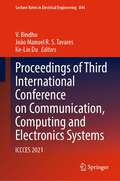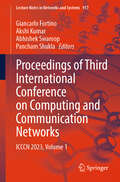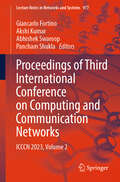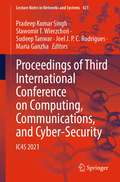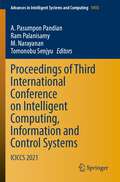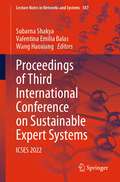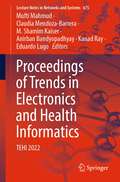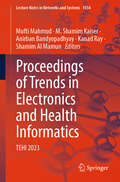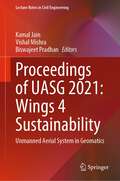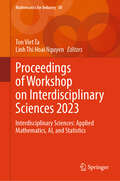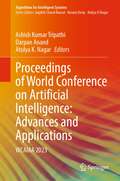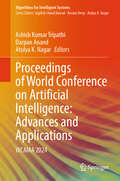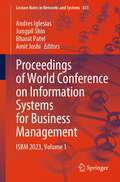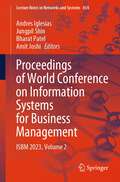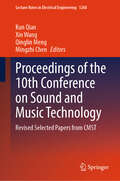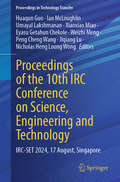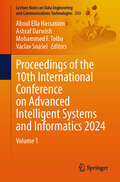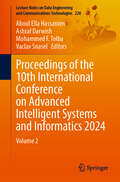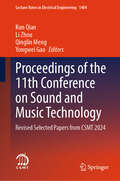- Table View
- List View
Proceedings of Third International Conference on Communication, Computing and Electronics Systems: ICCCES 2021 (Lecture Notes in Electrical Engineering #844)
by Ke-Lin Du João Manuel R. S. Tavares V. BindhuThis book includes high quality research papers presented at the International Conference on Communication, Computing and Electronics Systems 2021, held at the PPG Institute of Technology, Coimbatore, India, on 28-29 October 2021. The volume focuses mainly on the research trends in cloud computing, mobile computing, artificial intelligence and advanced electronics systems. The topics covered are automation, VLSI, embedded systems, optical communication, RF communication, microwave engineering, artificial intelligence, deep learning, pattern recognition, communication networks, Internet of Things, cyber-physical systems, and healthcare informatics.
Proceedings of Third International Conference on Computing and Communication Networks: ICCCN 2023, Volume 1 (Lecture Notes in Networks and Systems #917)
by Giancarlo Fortino Akshi Kumar Abhishek Swaroop Pancham ShuklaThis book includes selected peer-reviewed papers presented at third International Conference on Computing and Communication Networks (ICCCN 2023), held at Manchester Metropolitan University, UK, during 17–18 November 2023. The book covers topics of network and computing technologies, artificial intelligence and machine learning, security and privacy, communication systems, cyber physical systems, data analytics, cyber security for industry 4.0, and smart and sustainable environmental systems.
Proceedings of Third International Conference on Computing and Communication Networks: ICCCN 2023, Volume 2 (Lecture Notes in Networks and Systems #977)
by Giancarlo Fortino Akshi Kumar Abhishek Swaroop Pancham ShuklaThis book includes selected peer-reviewed papers presented at third International Conference on Computing and Communication Networks (ICCCN 2023), held at Manchester Metropolitan University, UK, during 17–18 November 2023. The book covers topics of network and computing technologies, artificial intelligence and machine learning, security and privacy, communication systems, cyber-physical systems, data analytics, cybersecurity for Industry 4.0, and smart and sustainable environmental systems.
Proceedings of Third International Conference on Computing, Communications, and Cyber-Security: IC4S 2021 (Lecture Notes in Networks and Systems #421)
by Pradeep Kumar Singh Sudeep Tanwar Joel J. P. C. Rodrigues Maria Ganzha Sławomir T. WierzchońThis book features selected research papers presented at the Third International Conference on Computing, Communications, and Cyber-Security (IC4S 2021), organized in Krishna Engineering College (KEC), Ghaziabad, India, along with Academic Associates; Southern Federal University, Russia; IAC Educational, India; and ITS Mohan Nagar, Ghaziabad, India, during October 30–31, 2021. It includes innovative work from researchers, leading innovators, and professionals in the area of communication and network technologies, advanced computing technologies, data analytics and intelligent learning, the latest electrical and electronics trends, and security and privacy issues.
Proceedings of Third International Conference on Intelligent Computing, Information and Control Systems: ICICCS 2021 (Advances in Intelligent Systems and Computing #1415)
by A. Pasumpon Pandian Tomonobu Senjyu Ram Palanisamy M. NarayananThis book is a collection of papers presented at the International Conference on Intelligent Computing, Information and Control Systems (ICICCS 2021). It encompasses various research works that help to develop and advance the next-generation intelligent computing and control systems. The book integrates the computational intelligence and intelligent control systems to provide a powerful methodology for a wide range of data analytics issues in industries and societal applications. The book also presents the new algorithms and methodologies for promoting advances in common intelligent computing and control methodologies including evolutionary computation, artificial life, virtual infrastructures, fuzzy logic, artificial immune systems, neural networks and various neuro-hybrid methodologies. This book is pragmatic for researchers, academicians and students dealing with mathematically intransigent problems.
Proceedings of Third International Conference on Intelligent System: ICIS 2024 (Algorithms for Intelligent Systems)
by João Manuel R. S. Tavares Souvik Pal Le Hoang Son Binh Thai Pham Nguyen Hoang LongThis book gathers selected high-quality research papers presented at the Third International Conference on Intelligent System (ICIS 2024), organized by University of Transport Technology, Hanoi, Vietnam, during 24–25 October 2024. It discusses high-quality and cutting-edge research in the areas of informatics, intelligent systems, and smart technologies and applications. The book is a collection of the latest research articles in intelligent control, artificial intelligence, neural networks, knowledge discovery, decision support systems, soft computing, data mining, and ontologies, machine learning, intelligent measurement, and other related fields.
Proceedings of Third International Conference on Sustainable Computing: SUSCOM 2021 (Advances in Intelligent Systems and Computing #1404)
by Dharm Singh Jat Ramesh Chandra Poonia Mario José Diván Vijander Singh Mohammed S. KhanThe book includes a selection of the best papers presented at the Third International Conference on Sustainable Computing (SUSCOM 2021), held in Jaipur, India, during 19 – 20 March 2021. It covers topics like Internet of things (IoT); artificial system of security; smart storage and knowledge retrieval using data cloud; intelligent transport management; intelligent cognitive and bio-inspired computing and management science. The book is useful for peoples from academia, government bodies, healthcare and industry to discuss their future scope.
Proceedings of Third International Conference on Sustainable Expert Systems: ICSES 2022 (Lecture Notes in Networks and Systems #587)
by Valentina Emilia Balas Subarna Shakya Wang HaoxiangThis book features high-quality research papers presented at the 3rd International Conference on Sustainable Expert Systems (ICSES 2022), held in Nepal during September 9–10, 2022. The book focuses on the research information related to artificial intelligence, sustainability and expert systems applied in almost all the areas of industries, government sectors and educational institutions worldwide. The main thrust of the book is to publish the conference papers that deal with the design, implementation, development, testing and management of intelligent and sustainable expert systems and also to provide both theoretical and practical guidelines for the deployment of these systems.
Proceedings of Trends in Electronics and Health Informatics: TEHI 2021 (Lecture Notes in Networks and Systems #376)
by Kanad Ray Anirban Bandyopadhyay M. Shamim Kaiser Raghvendra Singh Vishal NagarThis book includes selected peer-reviewed papers presented at the International Conference on Trends in Electronics and Health Informatics (TEHI 2021), organized by Department of Electronics and Communication Engineering and Department of Computer Science and Engineering, Pranveer Singh Institute of Technology Kanpur, India, during 16–17 December 2021. The book is broadly divided into five sections—artificial intelligence and soft computing, healthcare informatics, Internet of things and data analytics, electronics, and communications.
Proceedings of Trends in Electronics and Health Informatics: TEHI 2022 (Lecture Notes in Networks and Systems #675)
by Kanad Ray Anirban Bandyopadhyay Mufti Mahmud M. Shamim Kaiser Claudia Mendoza-Barrera Eduardo LugoThis book includes selected peer-reviewed papers presented at the International Conference on Trends in Electronics and Health Informatics (TEHI 2022), held at University of Puebla, Puebla, México, during December 7–9, 2022. The book is broadly divided into five sections—artificial intelligence and soft computing, healthcare informatics, Internet of things and data analytics, electronics, and communications.
Proceedings of Trends in Electronics and Health Informatics: TEHI 2023 (Lecture Notes in Networks and Systems #1034)
by Kanad Ray Anirban Bandyopadhyay Mufti Mahmud M. Shamim Kaiser Shamim Al MamunThis book includes selected peer-reviewed papers presented at the International Conference on Trends in Electronics and Health Informatics (TEHI 2023), held at Institute of Information Technology, Jahangirnagar University, Dhaka, Bangladesh, during December 26–27, 2023. The book is broadly divided into five sections—artificial intelligence and soft computing, healthcare informatics, Internet of things and data analytics, electronics, and communications.
Proceedings of UASG 2021: Unmanned Aerial System in Geomatics (Lecture Notes in Civil Engineering #304)
by Biswajeet Pradhan Kamal Jain Vishal MishraThis volume gathers the latest advances, innovations, and applications in the field of geographic information systems and unmanned aerial vehicle (UAV) technologies, as presented by leading researchers and engineers at the 2nd International Conference on Unmanned Aerial System in Geomatics (UASG), held in Roorkee, India on April 2-4, 2021. It covers highly diverse topics, including photogrammetry and remote sensing, surveying, UAV manufacturing, geospatial data sensing, UAV processing, visualization, and management, UAV applications and regulations, geo-informatics and geomatics. The contributions, which were selected by means of a rigorous international peer-review process, highlight numerous exciting ideas that will spur novel research directions and foster multidisciplinary collaboration among different specialists.
Proceedings of Workshop on Interdisciplinary Sciences 2023: Interdisciplinary Sciences: Applied Mathematics, AI, and Statistics (Mathematics for Industry #38)
by Ton Viet Ta Linh Thi Hoai NguyenThis volume features a selection of technical papers presented at the workshop “The Fifth Workshop on Interdisciplinary Sciences (WIS 2023)". Contributions from esteemed researchers and academics in applied mathematics, AI, and statistics offer valuable insights into their latest research. The papers also delve into interdisciplinary applications, spanning fields such as agriculture and economics, with strong emphasis on data analysis techniques. We hope this proceedings volume will serve as a valuable resource for scholars, researchers, and practitioners interested in the recent advancements and emerging trends in interdisciplinary sciences.
Proceedings of World Conference on Artificial Intelligence: WCAIAA 2023 (Algorithms for Intelligent Systems)
by Atulya K. Nagar Ashish Kumar Tripathi Darpan AnandThis book is a collection of outstanding research papers presented at the World Conference on Artificial Intelligence: Advances and Applications (WCAIAA 2023), organized by Sir Padampat Singhania University, India and is technically sponsored by Soft Computing Research Society during March 18–19, 2023. The topics covered are agent-based systems, evolutionary algorithms, approximate reasoning, bioinformatics and computational biology, artificial intelligence in modeling and simulation, natural language processing, brain-machine interfaces, collective intelligence, computer vision and speech understanding, data mining, swarm intelligence, machine learning, human-computer interaction, intelligent sensor, devices and applications, and intelligent database systems.
Proceedings of World Conference on Artificial Intelligence: WCAIAA 2024 (Algorithms for Intelligent Systems)
by Atulya K. Nagar Ashish Kumar Tripathi Darpan AnandThis book is a collection of outstanding research papers presented at the World Conference on Artificial Intelligence: Advances and Applications (WCAIAA 2024), organized by Sir Padampat Singhania University, India, and is technically sponsored by Soft Computing Research Society during February 22–23, 2024. The topics covered are agent-based systems, evolutionary algorithms, approximate reasoning, bioinformatics and computational biology, artificial intelligence in modeling and simulation, natural language processing, brain–machine interfaces, collective intelligence, computer vision and speech understanding, data mining, swarm intelligence, machine learning, human–computer interaction, intelligent sensor, devices and applications, and intelligent database systems.
Proceedings of World Conference on Information Systems for Business Management: ISBM 2023, Volume 1 (Lecture Notes in Networks and Systems #833)
by Amit Joshi Bharat Patel Andres Iglesias Jungpil ShinThis book includes selected papers presented at World Conference on Information Systems for Business Management (ISBM 2023), held in Bangkok, Thailand, during September 7–8, 2023. It covers up-to-date cutting-edge research on data science, information systems, infrastructure and computational systems, engineering systems, business information systems, and smart secure systems.
Proceedings of World Conference on Information Systems for Business Management: ISBM 2023, Volume 2 (Lecture Notes in Networks and Systems #834)
by Amit Joshi Bharat Patel Andres Iglesias Jungpil ShinThis book includes selected papers presented at World Conference on Information Systems for Business Management (ISBM 2023), held in Bangkok, Thailand, during September 7–8, 2023. It covers up-to-date cutting-edge research on data science, information systems, infrastructure and computational systems, engineering systems, business information systems, and smart secure systems.
Proceedings of the 10th Conference on Sound and Music Technology: Revised Selected Papers from CMST (Lecture Notes in Electrical Engineering #1268)
by Xin Wang Kun Qian Qinglin Meng Mingzhi ChenThe book presents selected papers at the 10th Conference on Sound and Music Technology (CSMT) held in June 2023, China. CSMT is a multidisciplinary conference focusing on audio processing and understanding with bias on music and acoustic signals. The primary aim of the conference is to promote the collaboration between art society and technical society in China. In this book, the paper included covers a wide range topic from speech, signal processing, music understanding, machine learning, and signal processing for advanced medical diagnosis and treatment applications, which demonstrates the target of CSMT merging arts and science research together. Its content caters to scholars, researchers, engineers, artists, and education practitioners not only from academia but also industry, who are interested in audio/acoustics analysis signal processing, music, sound, and artificial intelligence (AI).
Proceedings of the 10th IRC Conference on Science, Engineering and Technology: IRC-SET 2024, 17 August, Singapore (Proceedings in Technology Transfer)
by Weizhi Meng Huaqun Guo Eyasu Getahun Chekole Umayal Lakshmanan Ian McLoughlin Peng Cheng Wang Jiqiang Lu Nicholas Heng Loong Wong Xiaoxiao MiaoThis book presents peer reviewed articles from IRC-SET 2024 held on 17August in Singapore. It highlights the contemporary state of research in multi-disciplinary areas of Computer Science, Computer Engineering, Data Science, Electrical and Electronics Engineering, Chemical Engineering, Mechanical Engineering, Physics, Biomedical Sciences, Life Sciences, Medicine, Healthcare, and Business Technology. The papers presented here were shortlisted after extensive rounds of rigorous reviews by a panel of esteemed individuals who are pioneers and experts in their respective domains.
Proceedings of the 10th International Conference on Advanced Intelligent Systems and Informatics 2024: Volume 1 (Lecture Notes on Data Engineering and Communications Technologies #233)
by Ashraf Darwish Václav Snášel Aboul Ella Hassanien Mohamed F. TolbaThis book includes recent research on intelligent systems and informatics. It constitutes the proceedings of the 10th International Conference on Advanced Intelligent Systems and Informatics. It presents scientific research on all aspects of informatics and intelligent systems including current research in deep learning, machine learning-based applications, real-time system, business intelligence, digital economic, ChatGPT, and reality of E-learning and education.
Proceedings of the 10th International Conference on Advanced Intelligent Systems and Informatics 2024: Volume 2 (Lecture Notes on Data Engineering and Communications Technologies #220)
by Ashraf Darwish Vaclav Snasel Aboul Ella Hassanien Mohammed F. TolbaThis book contains a collection of research that discusses the latest ideas, applications, and technology related to smart systems, including medical applications, business intelligence, and intelligent-based education. In addition to some papers that shows how is artificial intelligence technologies deals with some problems related to environmental and sustainability.
Proceedings of the 10th International Conference on Business, Accounting, Finance and Economics (Advances in Economics, Business and Management Research #234)
by Fanyu Chen Keng Soon William Choo Voon Hsien Lee Chooi Yi WeiThis is an open access book. The Faculty of Business and Finance, Universiti Tunku Abdul Rahman (UTAR) is pleased to organize the 10th International Conference on Business, Accounting, Finance, and Economics (BAFE 2022) on 11th October 2022 in virtual mode via Microsoft Teams or Zoom platform. This conference aims to bring together researchers to present up-to-date works that contribute to new theoretical, methodological and empirical knowledge
Proceedings of the 10th International Conference on Fracture Fatigue and Wear: FFW 2022, 2-3 August, Ghent University, Belgium (Lecture Notes in Mechanical Engineering)
by Magd Abdel WahabThis book gathers a selection of peer-reviewed papers presented at the 10th International Conference on Fracture Fatigue and Wear (FFW 2022), held in the city of Ghent, Belgium, on August 2–3, 2022. The contributions, prepared by international scientists and engineers, cover the latest advances in and innovative applications of fracture mechanics, fatigue of materials, tribology, and wear of materials. In addition, they discuss industrial applications and cover theoretical and analytical methods, numerical simulations, and experimental techniques. The book is intended for academics, including graduate students and researchers, as well as industrial practitioners working in the areas of fracture fatigue and wear.
Proceedings of the 10th International Ergonomics Conference: ERGONOMICS 2024 (Springer Series in Design and Innovation #53)
by Tanja Jurčević Lulić Jasna Leder Horina Dorotea Kovačević Martina Lovrenić-JugovićThis book presents the proceedings of the 10th International Ergonomics Conference (ERGONOMICS 2024), held in Zagreb, Croatia, on December 5–6, 2024. By highlighting the latest theories and models, as well as cutting-edge technologies and applications, and by combining findings from a range of disciplines including engineering, design, robotics, health care, management, computer science, human biology, and behavioral science, it provides researchers and practitioners alike with a comprehensive, timely guide on human factors and ergonomics. It also offers an excellent source of innovative ideas to stimulate future discussions and developments aimed at applying knowledge and techniques to optimize system performance, while at the same time promoting the health, safety, and well-being of individuals. The book includes papers from researchers and practitioners, scientists and physicians, institutional leaders, managers, and policymakers that contribute to constructing the human factors and ergonomics approach across a variety of methodologies, domains, and productive sectors.
Proceedings of the 11th Conference on Sound and Music Technology: Revised Selected Papers from CSMT 2024 (Lecture Notes in Electrical Engineering #1404)
by Kun Qian Li Zhou Yongwei Gao Qinglin MengThis book presents selected papers at the 11th Conference on Sound and Music Technology (CSMT) held in October 2024, Wuhan, China. CSMT is a multidisciplinary conference focusing on audio processing and understanding with bias on music and acoustic signals. The primary aim of the book is to promote the collaboration between art society and technical society in China. In this book, the paper included covers a wide range topic from speech, signal processing, music understanding, machine learning, and signal processing for advanced medical diagnosis and treatment applications, which demonstrates the target of CSMT merging arts and science research together. Its content caters to scholars, researchers, engineers, artists, and education practitioners not only from academia but also industry, who are interested in audio/acoustics analysis signal processing, music, sound, and artificial intelligence (AI).
